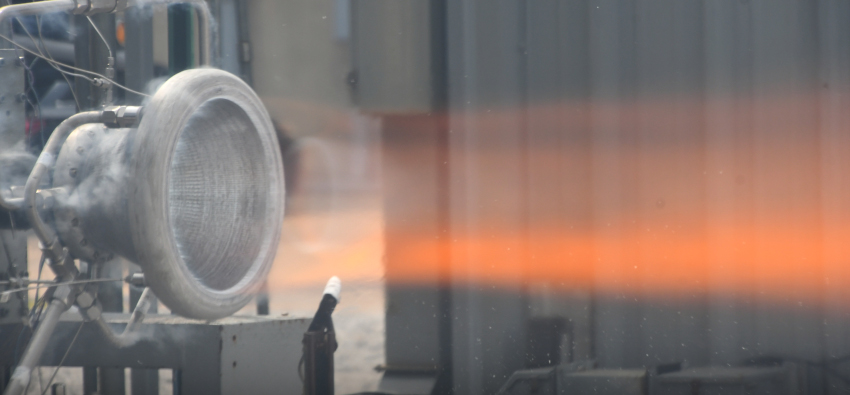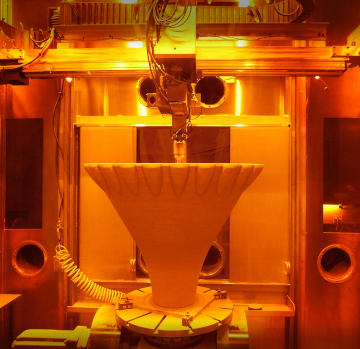
NASA’s 3D-printed aluminum rocket nozzle passes hot-fire tests
By DE Staff
Additive Manufacturing Aerospace Metal FabricationNovel alloy enables the creation of the light-weight rocket engines needed for deep space exploration.

NASA’s RAMFIRE nozzle during a hot fire test at the space agency’s Marshall Space Flight Center. Compose of a novel aluminum alloy, 6061-RAM2, the nozzle can withstand huge temperature gradients, from the 6000 degrees Fahrenheit generated by the hot gas combustion to the icicles forming on the nozzle’s exterior.
(Image Credit: NASA)
NASA recently announced that it has built and performed multiple hot-fire tests on two nozzles, additively manufactured from a novel aluminum alloy, as part of its RAMFIRE project. Short for Reactive Additive Manufacturing for the Fourth Industrial Revolution, the RAMFIRE project seeks to 3D print rocket engines, that are as strong but lighter than conventional engines, to enable deep space exploration as part of the space agency’s Moon to Mars program.
While aluminum has always been prized for its lightweight and strength, it hasn’t previously been a good choice to make rocket engines, NASA says, due to its intolerance to extreme heat and tendency to crack when welded or 3D printed.
However, engineers from NASA’s Marshall Space Flight Center worked with Erie, Colorado’s Elementum 3D, to develop A6061-RAM2, a weldable, heat resistant aluminum variant, as well as, a powered form that could be used for 3D printing. The space agency then turned to commercial partner, RPM Innovations (RPMI), to additively manufacture the RAMFIRE project nozzles using the Laser Powder Directed Energy Deposition (LP-DED) printing process.

Additive manufacturing of a large-scale aerospike demonstration nozzle at the RPM Innovation (RPMI) facility in Rapid City, South Dakota. The laser powder directed energy deposition (LP-DED) process blows powder into a melt pool, created by a laser, to deposit material layer by layer.
(Photo credit: RPM Innovation)
According to NASA, 3D printing the rocket nozzle is critical for a number of reason, not least of which is the manufacturing time savings. Nozzles built using conventional methods may have upwards of 1000 parts that have to be assembled and joined, whereas a 3D printed nozzle is built as a single piece. In addition, additive manufacturing allows for the inclusion of small and complex internal cooling channels into the RAMFIRE nozzle to prevent melting.
In testing, the 3D printed A6061-RAM2 nozzles have outperformed expectations. During the hot-fire tests, carried out this summer at Marshall’s East Test Area, the two RAMFIRE nozzles successfully accumulated 22 starts and nearly 10 minutes of run time, the space agency says. Completed using both liquid oxygen / liquid hydrogen and liquid oxygen / liquid methane fuels, the tests also put the nozzles under pressures in excess of 825 pounds per square inch (psi), more than anticipated.
“This test series marks a significant milestone for the nozzle,” said Paul Gradl, RAMFIRE principal investigator at NASA Marshall. “After putting the nozzle through the paces of a demanding hot-fire test series, we’ve demonstrated the nozzle can survive the thermal, structural and pressure loads for a lunar lander scale engine.”
In addition to rocket engine nozzles, the RAMFIRE project also used LP-DED printing and the A6061-RAM2 aluminum to create a 36-inch diameter aerospike nozzle, with similar complex coolant channels and a vacuum-jacketed tank for cryogenic fluid applications.
With the testing successfully completed, NASA says it is currently sharing the data and process details with academics and commercial stakeholders, including aerospace companies that are evaluating the A6061-RAM2 alloy and the LP-DED process to make components for satellites and other applications.
www.nasa.org
www.elementum3d.com
www.rpm-innovations.com
